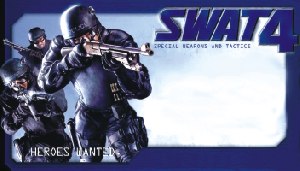
By
Ziad
Your ultimate
goal is to arrest suspects, not kill them. As with the real-life SWAT
teams, your job as an element commander in SWAT 4 is to take your
five-man team into dangerous situations and defuse them. These situations
range from a botched jewelry heist to high-risk arrest warrants to
a raid on an illegal casino. In almost every mission, there are innocent
civilians mixed in with the bad guys. Even when you do run into armed
criminals, you don't have carte blanche to shoot them immediately.
You have to follow the same strict rules of engagement as a real police
officer and do whatever you can to subdue and arrest suspects without
lethal force. Your guns are meant to be a last resort and should only
be used if an armed suspect is an immediate threat to your team or
civilians. At the end of each mission you're graded on how well you
did, and more points are awarded for arresting as opposed to killing
suspects. You are assessed big point penalties for improper use of
force, and for the most part, these penalties are levied fairly and
intuitively.
The
14-mission campaign isn't linked in any way. There's no overarching
storyline that connects them all, so the campaign plays out just like
a series of stand-alone missions. It starts you off with a training
level that does a good job of acquainting you with the basics of using
your weapons and commanding your teams. It's here that you're introduced
to the game's interface. Your four subordinates are divided into a
pair of two-man groups: red and blue. You can issue orders to the
entire element or to each pair separately. Switching between the groups
is done by tapping a key. Aim at a locked door and you can order your
men to pick the lock or blow it open with a charge or breaching shotgun.
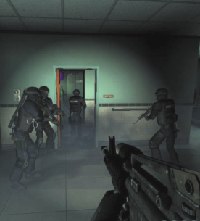 The
context-sensitive interface extends to a multipurpose use button as
well. Point it at a suspect or hostage, and the use button will cause
you to yell at the person to put his hands up and surrender. You'll
be doing this a lot in SWAT 4, as you attempt to get suspects to respect
your authority before shooting them. Point your cursor at a dropped
weapon and you can pick it up to secure it. Aim at a cuffed criminal
or civilian and your use key will radio a status report into command.
The
context-sensitive interface extends to a multipurpose use button as
well. Point it at a suspect or hostage, and the use button will cause
you to yell at the person to put his hands up and surrender. You'll
be doing this a lot in SWAT 4, as you attempt to get suspects to respect
your authority before shooting them. Point your cursor at a dropped
weapon and you can pick it up to secure it. Aim at a cuffed criminal
or civilian and your use key will radio a status report into command.
There are also
interface options that allow you to remotely command one of your squad
elements. For example, you can order red team to stack up at a door,
and then leave them there while you take blue team around the corner
to a second door (which leads into the same room). Even though you're
out of visual range of red team, you can bring up a picture-in-picture
window of what red team is seeing, and through that window you can
order them to enter the door they're standing in front of. This is
a neat option that allows you to simultaneously enter a room that
has two doors.
Before going on each mission you can listen to a quick briefing, and
this presentation is done well. SWAT 4 includes a good selection of
assault rifles, submachine guns, shotguns, and nonlethal weapons like
Taser guns, pepper spray, and a paintball gun modified to shoot pepper
balls. You can also choose between ammo types like hollow-point bullets
for more stopping power against unarmored suspects, or full metal
jacket for better penetration against body armor. The grenades and
gadgets are probably the most important selections. You'll need to
carry in flashbang and tear gas grenades for assaulting rooms, and
you also have special gear like the Optiwand, which is a fiber-optic
camera used for peeking around corners and under doors. Door wedges
allow you to seal off exits to keep suspects from running away into
rooms you've already cleared.
Once you're actually
in a mission, you'll find that the game rewards patient and deliberate
play. The nature of SWAT 4 as a realistic simulator is that it's very
easy for you and your team to get wiped out if you make any kind of
mistake. Charging into rooms without first tossing in some kind of
grenade to incapacitate or distract suspects inside is a surefire
recipe for disaster. As a result, once you get the feel of the game,
you'll find that the gameplay in SWAT 4 is fairly methodical, punctuated
by a few brief moments of intense action. Stick an Optiwand under
a door to check for occupants, open (or blow open) the door, toss
in a grenade, then rush in and clear threats. Repeat on the next door.
What ends up complicating
matters is the varied artificial intelligence of the enemies and hostages
you find. Some criminals will give up the moment you yell at them
to drop their weapons. Others won't surrender unless you incapacitate
them with a flashbang or tear gas, or even a Taser gun shock. Some
immediately shoot back, while others will try to run away and escape
into other rooms. Bold suspects may even run into the room you're
in and unexpectedly attack you. Hostages are equally unpredictable
in how they behave. Most hostages comply immediately, but some need
to be hit with a nonlethal weapon before they can be restrained.
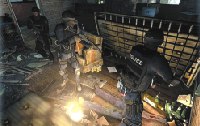 The
fun in SWAT 4 comes in trying to sort out all the mess and bring order
to the chaos while remaining within a police officer's rules of engagement.
Thankfully, the AI of your squadmates is generally smart enough to
handle most situations. They're usually good about engaging suspects
and only shooting them when appropriate. They're also extremely accurate
when called upon to fire. Your squadmates are even smart about moving
up and down stairways and keeping their weapons pointed up or down
as appropriate. Despite the flaws, SWAT 4 is extremely unique in its
gameplay style and premise, and it executes cleanly for the most part.
What's more, suspects and hostages spawn randomly in each level every
time you play, which adds a great deal of replayability to the game.
No matter how many times you've played a mission, you can never be
too sure of the whereabouts of suspects, which makes for a consistently
intense experience. Replaying levels does make them easier over time,
but that's not from memorizing the locations of enemies, it's from
gaining a better understanding of the building architecture, which
plays a huge role in the game.
The
fun in SWAT 4 comes in trying to sort out all the mess and bring order
to the chaos while remaining within a police officer's rules of engagement.
Thankfully, the AI of your squadmates is generally smart enough to
handle most situations. They're usually good about engaging suspects
and only shooting them when appropriate. They're also extremely accurate
when called upon to fire. Your squadmates are even smart about moving
up and down stairways and keeping their weapons pointed up or down
as appropriate. Despite the flaws, SWAT 4 is extremely unique in its
gameplay style and premise, and it executes cleanly for the most part.
What's more, suspects and hostages spawn randomly in each level every
time you play, which adds a great deal of replayability to the game.
No matter how many times you've played a mission, you can never be
too sure of the whereabouts of suspects, which makes for a consistently
intense experience. Replaying levels does make them easier over time,
but that's not from memorizing the locations of enemies, it's from
gaining a better understanding of the building architecture, which
plays a huge role in the game.
The
biggest downside to the game's graphics is that the frame rate can
be a big issue. SWAT 4 chugs noticeably on machines with 512MB of
RAM. Upgrading to 1GB can make most situations play out a lot smoother,
but in intense firefights with tear gas in the air and multiple suspects
and squadmates firing, the frame rate still takes a big nosedive

Review
by Gokhra |
Gothika
has been out for some time too but it requires a menton because it
is way too cool. Sort of. Gothika is a sleek, fast nightmare thriller.
The story has a very engrossing beginning.
The plot: Halle
Berry's Miranda Grey is a smart, spiffy psychiatrist married to fatherly
Dr. Douglas Grey (Charles Dutton), the psychiatric head at Woodward
Penitentiary for Women. Seems a lot of others are also smitten with
here including Pete Graham (Robert Downey Jr.) and some of the scarier
female patients, like Chloe Sava (Penelope Cruz).
One night while
Miranda is heading home to meet up with her husband bad weather forces
her to take a detour through a lonely stretch of road while talking
on the cell phone. We all know that bad things go wrong when talking
on cell phones while driving in a deserted road. Psycho killers come
up and aliens abduct or even become abducted. In this case, a blond
girl materializes in the middle of the road causing Miranda to veer
off and crash. She steps out of the car to help the girl who is dressed
in underwear and has scratches all over her body. The girl is a ghost
who simply bursts into flames and a shock cut takes us to Miranda
opening her eyes to find herself locked inside the psychiatric cell
becoming a patient that she herself used to treat.
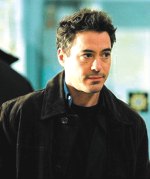 She's
accused of killing her husband with "Psycho"-like gruesomeness.
Blood, decapitation and writings on the wall (in blood). Everybody
saw them as a happy coupe so it as bewildering that one night she
would just turn up at her house and chop her husband to pieces with
an axe no less. So why would she just snap like that? Or is there
something more that we can't see?
She's
accused of killing her husband with "Psycho"-like gruesomeness.
Blood, decapitation and writings on the wall (in blood). Everybody
saw them as a happy coupe so it as bewildering that one night she
would just turn up at her house and chop her husband to pieces with
an axe no less. So why would she just snap like that? Or is there
something more that we can't see?
The
rest of the movie shows Miranda trapped in a nightmare, persecuted
or misunderstood by almost everybody, including the dead husbands
angry best friend, Sheriff Ryan (John Carroll Lynch). She sees the
ghost often and is even attacked by her. Subsequently it seems that
the ghost attacks actually help her to break out of jail, with incredible
ease, to try to solve the mystery. You see, the ghost is that of a
girl who supposedly committed  suicide
years ago by jumping off a bridge. But maybe the girl was killed and
is out for revenge of some twisted sort. Or maybe the ghost is simply
just a mean spirit who likes to possess hot female bodies Halle Barry's
for instance) and go on a chopping spree.
suicide
years ago by jumping off a bridge. But maybe the girl was killed and
is out for revenge of some twisted sort. Or maybe the ghost is simply
just a mean spirit who likes to possess hot female bodies Halle Barry's
for instance) and go on a chopping spree.
The
verdict: The rest of the movie takes you on a wild ride with equally
wild plot twists just to solve that particular mystery. Gothika is
like Halle Berry in the film, it looks good but acts crazy. There
are instances when you will be wondering about some plot holes. For
example why can't the ghost just calmly tell Miranda what is going
on 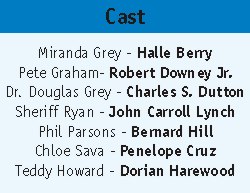 instead of throwing
her against shelf and even slicing up her arm? Well, that wouldn't
be scary now would it?
instead of throwing
her against shelf and even slicing up her arm? Well, that wouldn't
be scary now would it?
As with thrillers,
don't go looking for too much plausibility. The movie is whip-fast
and drenched in atmosphere. So, relax soak in the unfolding story.
The classy actors (especially Downey Jr. and Dutton) supply style
and edge to the core idea of a psychiatrist-turned-inmate. It's a
brilliant movie and is a must for anyone's collection.
Celebrity Spotlight
Kate
Winslet
 Birth
Name: Kate Elizabeth Winslet
Birth
Name: Kate Elizabeth Winslet
Height: 5' 8"
Nationality: British
Birth Date: October 5, 1975
Birth Place: Reading, Berkshire, England, UK
Education: Redroofs School in Maidenhead, U.K.
Studied at drama school in UK
Husband/Wife: Sam Mendes (director; born on August
1, 1965; married in May 2003), Jim Threapleton (assistant director;
born in 1974; met during filming of Hideous Kinky in 1997; engaged
in October 1998; married on November 22, 1998; separated in September
2001)
Father: Roger Winslet (actor)
Mother: Sally Winslet (née Bridges; actress,
nanny)
Sister: Beth Winslet (actress; born in May 1978),
Anna Winslet (actress; born in 1972)
Brother: Joss Winslet (born in 1980)
Grand Father: Oliver Bridges (theater manager)
Grand Mother: Linda Bridges (theater manager)
Uncle: Robert Bridges (actor)
Son: Joe Mendes (born on December 22, 2003 in New
York; father: Sam Mendes)
Daughter: Mia (born on October 12, 2000; father:
Jim Threapleton)
Claim to fame: as Rose DeWitt Bukater in James Cameron
Titanic (1997)
Kate
Winslet has been described as "the most gifted actress of her
generation" and "champagne and caviar for movie-goers with
good taste". At the age of 22, she was the youngest actor to
receive two Academy Awards nominations, and at 26 she became the youngest
actress to have been nominated three times. Her honors include a Screen
Actors Guild award, British Academy Award, European Film People's
Choice Award, and numerous critics and fan awards. She starred in
the biggest box office hit in history, "Titanic", but most
often chooses interesting roles in independent films. Kate's most
recent release is "Finding Neverland" with Johnny Depp.
In January 2005, at the age of 29, Kate received her fourth Academy
Award nomination for her performance in "Eternal Sunshine of
the Spotless Mind"
It was Kate's
destiny to be in the performing arts. She is a well-seasoned actress
who comes from a long line of performing artists. Kate's grandparents
ran the Reading Repertory Theatre, her late uncle was a West End actor,
and her parents were stage actors. At age 11, Kate began taking acting
lessons in Maidenhead and secured her first acting role in a commercial
for Sugar Puffs cereal, dancing with the Honey Monster.
 Kate
attended a performing arts school and following her graduation, began
her career with roles in the British television drama Shrinks. She
has also appeared in television series; Casualty, Dark Season, Get
Back, and Anglo-Saxon Attitudes. Kate's theatrical roles include Pandora
in the musical "Adrian Mole", Wendy in "Peter Pan",
Sarah in "A Game of Soldier", and Geraldine in "What
the Butler Saw".
Kate
attended a performing arts school and following her graduation, began
her career with roles in the British television drama Shrinks. She
has also appeared in television series; Casualty, Dark Season, Get
Back, and Anglo-Saxon Attitudes. Kate's theatrical roles include Pandora
in the musical "Adrian Mole", Wendy in "Peter Pan",
Sarah in "A Game of Soldier", and Geraldine in "What
the Butler Saw".
Kate made her
move into films in 1994, with "Heavenly Creatures", where
she landed the starring role and received rave reviews for her film
debut. Screenwriter and producer, Emma Thompson, cast her at first
sight for the role in which Kate earned herself an Oscar nomination
for Best Supporting Actress. Kate has continued to distinguish herself
in other productions including Jude and Kenneth Branagh's "Hamlet".
Kate's most successful
movie to date has been "Titanic", playing the role of Rose
Dewitt Bukater, an upper class Philadelphian aboard the ill fated
ocean liner. Following the success of "Titanic", Kate starred
in some smaller films, such as "Hideous Kinky" set in Morocco,
and then starred in "Holy Smoke" opposite Harvey Keitel.
Another memorable work for Kate was seen in the film "Quills",
a film about the final days of the Marquis de Sade. Kate has also
starred in "Enigma" and "Iris" for which she has
picked up numerous awards.
Did
You Know?
Kate is in talks to star in the fourth HARRY POTTER movie as a French
wizard. (March 25, 2004)
Kate fainted during a scene in ETERNAL SUNSHINE OF THE SPOTLESS MIND
where she and co-star Jim Carey are in an oversized kitchen sink,
because the tub was too hot.
Quotable
Quotes
"My Neverland is where family is - where I am happiest."-Kate
Winslet
By
Quazi Zulquarnain Islam
